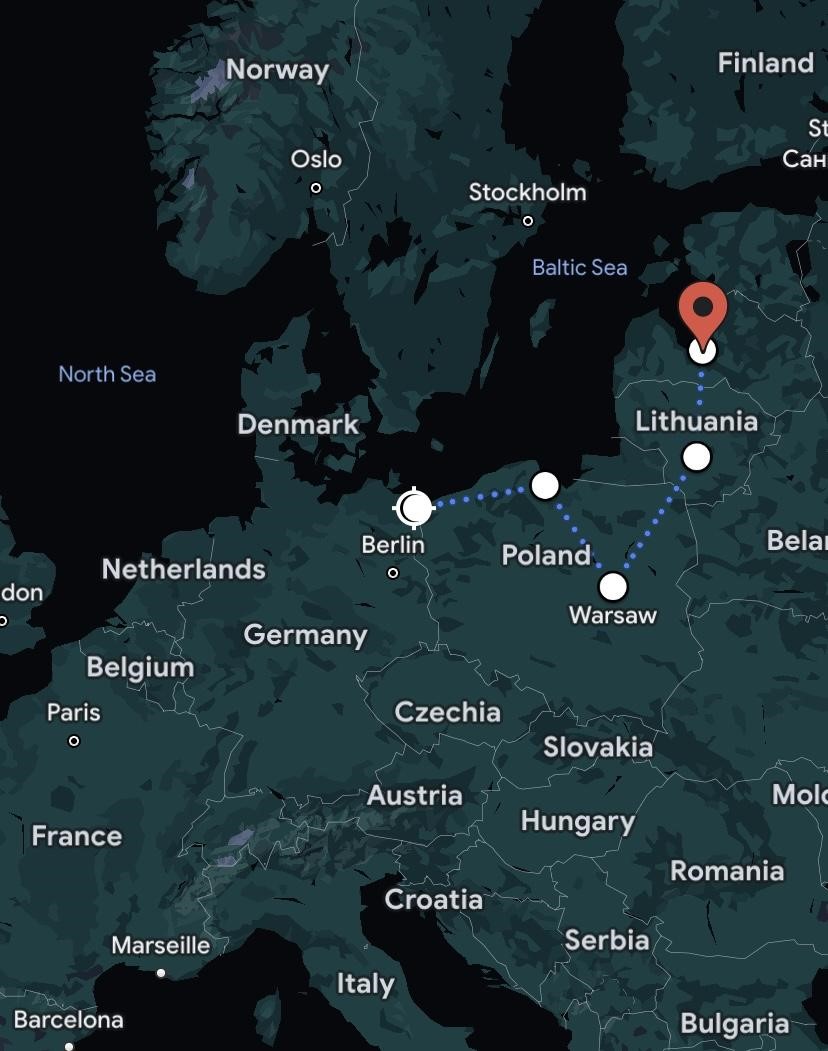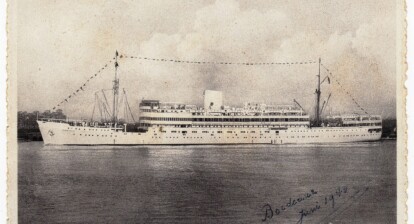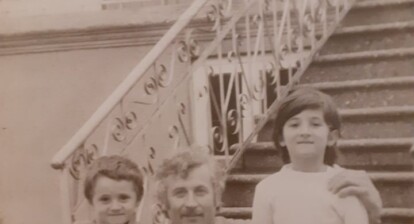One online application, four hours of sleep, and two flights later – that is how our author Sheenagh from Ireland, found herself in Riga, Latvia. Peace Line, an organisation that unites young people through history, had offered her a place on their Blue Route. The participants were to meet in Riga to set off on an unforgettable journey along historic traces of the Second World War in the Baltic region.
You Never Know Where You Might End Up
The German town of Kamminke was the final stop of our journey. After our arrival, my Slovakian roommate and I traded our application videos. We were laughing at the contrast in how we approached the question of why we wanted to take part in Peace Line – the answer to which eventually caused us to be accepted to the programme. Why had we even applied for this opportunity in the first place? As the story often goes, I had stumbled across Peace Line after hours of trolling the web for meaningful ways to spend my summer. Two weeks of travelling by bus, visiting war memorials, cemeteries, museums and concentration camps with peers from all over Europe sounded like a challenging, but perfect adventure. Especially for a history and travel enthusiast like myself.
Ignorance is Bliss

Peace Line’s 2023 Blue Route (photo: Google Maps)
Potential participants had the opportunity to apply for a variety of routes. The Yellow Route: to learn about the disintegration of Yugoslavia; the Green Route: to learn about the events of the World Wars; the Red Route: to learn about peace work and the European Union, and the Blue Route: to learn about the effects of World War II in the Baltic region. My interest in the Blue Route sparked because I knew so little about the region. The history of which had been largely ignored in my high school textbooks that preferred to focus on Anglo-Irish and Western European history. As I have never visited three of the four countries covered on our route, you can only imagine my excitement when my acceptance email arrived.
Two months later, I found myself in Dublin Airport ready to depart for Riga. Feeling slightly anxious, but mostly excited for the adventure ahead. I anticipated that I would learn a lot about Europe and its history. But I had never expected that I would learn so much about myself.
Getting To Know Each Other
As a group of 24 young people from 17 countries, our first two days were consumed by necessary introductions, Latvian lessons, and team-building exercises; after which we found ourselves in Riga’s German Baltic Youth Office. The relationship between Peace Line and the German Baltic Youth Office was fostered to connect the missions of cultural exchange held by the two organisations. This relationship is maintained as some members of the Youth Office have also become participants of Peace Line.
Throw Caution To The Wind
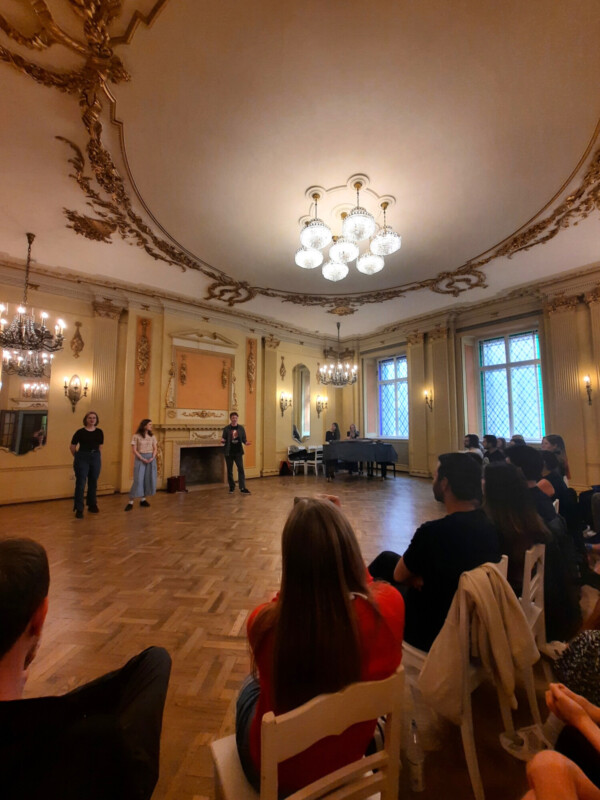
Participants receiving an introduction to traditional Latvian dancing (photo: private).
In this spirit of cultural exchange, we had been promised an evening of traditional Latvian dancing, hosted by a former Peace Line participant and his sister. At this moment, we were still in the timid stages of our blossoming friendships. Many of us cringed at the thought of holding hands with one another. Yet, with a suspected 300,000 Latvian folk songs in existence, it was no surprise that as the pace of the music increased, so did our enjoyment. So we swang into each other’s arms and learned to play Latvia’s national music symbol – the kokle. Hearing tales of Latvian folklore made another delightful evening icebreaker. This was truly the last thing I expected to do with people I had met just 48 hours prior. But that was the nature of such a trip. We bonded quickly through the unusual situations we found ourselves in.
Museums, museums, museums!
Our pre-departure schedule boasted visits to seven museums during our two weeks on the road. As a former volunteer at the National Museum of Ireland, I was glad to see their prominence on the agenda. But I also wondered if this number of museums would be ‘too much’. Would the proximity of museum visits compromise what we learned from them? And would they all begin to blur together in my memory? Thankfully, this was not the case.
Put Yourself In Someone Else’s Shoes
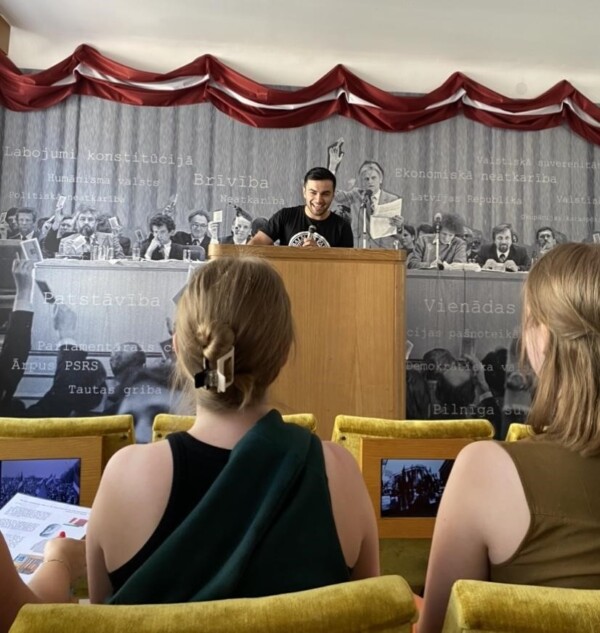
Participants try interactive activities at the Popular Front Museum in Riga, Latvia (photo: private).
I quickly realised that the museums did not merge in my memory, but clearly stood apart. This is because of the uniqueness of each; the stories they told and how they told them. For example, at the Popular Front Museum in Riga, we learned about the organisation of the Baltic Way through self-exploration and by engagement with the interactive elements of the museum. Yet, at the POLIN Museum in Warsaw, we learned about the history of Polish Jews through a guided tour. Thereby, the museum layout focused heavily on the remembrance of Jewish individuality. Learning about the history of this region of Europe by recounting stories, studying artefacts, and putting ourselves in someone else’s shoes allowed me to form my own image. This way was more more effective than the images any textbook could offer me.
Expect the Unexpected
Having fallen victim to a nap on our bus journey from Kaunas to Warsaw, I woke up 15 minutes before we arrived at our hotel. Peering out the window, I was genuinely shocked to see the skyscrapers before me. With Polish Nationals being the largest non-native population in my home country Ireland, I couldn’t understand why I had never been made aware of how sprawling and modern this city is. I stared out the window in disbelief. I thereby realised there was still a lot left for me to learn about this charming country.
The Best of Warsaw

Skyscrapers and relics of the former Jewish ghetto pictured in Warsaw, Poland (photo: private).
Luckily, our stay in Warsaw started with a guided tour of its city centre led by one of our Peace Line facilitators, Goska. In what quickly became known as Goska’s ‘Best of Warsaw’ Tour, I was brought up to speed on its history. Our casual walk through a street where several glass skyscrapers shadowed the former Jewish ghetto led me to confidently conclude that Warsaw is a city unlike any other . Being an international group, we found that our diversity went hand in hand with the variety of this city and its history. Before visiting Warsaw, I had expected it to look like most other European cities I’ve seen – with a charming old town, cobblestone streets and endless streams of canals.So I had an utterly inaccurate image of the city before our arrival. Our visit served as a further testament to my observation that we learn best through lived experience.
“No Big Deal”
Our bus journeys also challenged my preconceived ideas. Coming from a country where driving from the Northernmost point to the Southernmost point takes just 8 hours, you can imagine my initial surprise when a 7-hour drive from Poland to Germany was regarded by my peers as “no big deal”. Even on the first day of the programme, I complained about my 10-hour-long journey from Dublin to Riga, only to learn that it had taken my Ukrainian roommate 30 hours to get to Riga. It seems that in mainland Europe, 10 hours is a reasonable time to get from one country to another.
Seven Hours Well Spent
My initial dread of long bus rides was swiftly replaced with indifference, as I noticed how casually the other participants approached our travel days. My perspective on the bus also transformed from a centre of travel-sickness to a place of retreat. We played games, listened to music, ate packed lunches and caught up on sleep. On one 7-hour-long bus journey we made perfect use of our time by playing ‘Who Am I?‘. In this game we had to guess the name on our foreheads by only asking yes or no questions. From infamous European politicians to Belgian cartoon characters, a thread of our European identity seemed laced throughout everything we did.
Constantly Learning
I often felt like the bus journeys were a chance to escape from the programme. A moment to forget about some of the more difficult topics we had dealt with, and chat with friends. In retrospect, the time spent travelling by bus was also part of the programme’s aim. Listening to Serbian music, talking about Spanish politics, and explaining Irish independence; all these conversations continued to break down cultural and historical barriers on our quest for peace.
Confronting the Past
On the second week of our journey, we visited Stutthof Concentration Camp, a World War II camp about 35km east of Gdansk, Poland. Our group had mixed emotions before entering the camp, as it was not an experience that we knew how to prepare for. As many of us had not visited a concentration camp before, we didn’t know what to expect.
Upon entering the camp, we first saw a glass display case filled with shoes. Most of which were the shoes of people who died there. The atmosphere was somewhat uneasy because of the physical remnants of over 60,000 lives.
More Than A Story
Despite our uneasy feelings, the visit was beneficial in portraying the Holocaust in a more diversified way. We explored the narratives of thousands of victims, and not just the Jewish community. Depicting the history of this tragic event in a multi-faceted way is indicative of how we should commemorate and educate future generations about it – making sure that no single person or group is forgotten, preserving the most possible detail to make sure that such an atrocity will not happen again.
Our guided tour of Stutthof was coincidentally facilitated by one of our Peace Line route teamers. For us, it was so much more effective to hear the stories of the camp from someone we all considered as a friend. It made it feel more real. This tour in particular put our journey up until that point into a whole new light. We could begin to feel the intensity and reality of the history we had investigated. The stories we heard were so much more than stories, and we could only really begin to understand them once we acknowledged this.
A Bittersweet Goodbye
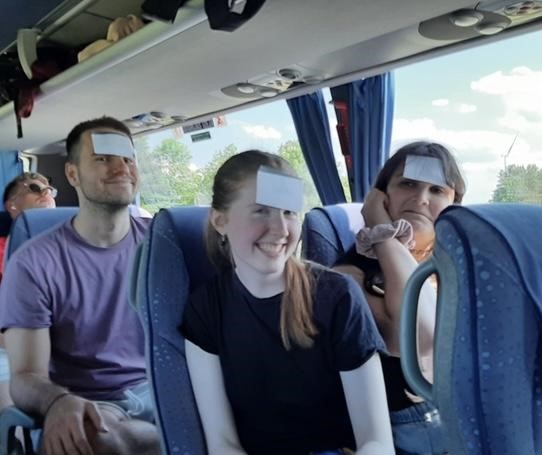
Seven Hours Well Spent: Participants playing games on the bus (photo: private)
Feeling inspired, emotional and somewhat well-educated, eventually the time came to return home. Saying goodbye to the people I had laughed with, cried with, and spent 24 hours a day with for the last two weeks was no easy feat. Yet, I knew I had made enough memories to last a lifetime.
Reflecting on my initial expectations, I learned much about Europe and its history. As the end of the programme came, so did my final recognition of the importance of learning about history through our own experiences, sharing stories of the past and making sure we do everything in our power to strive for an integrated, welcoming and peaceful Europe.

